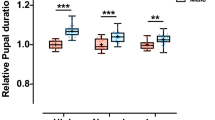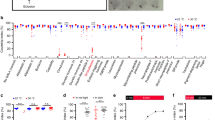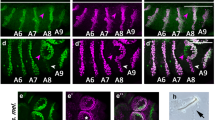Abstract
Current models describe male-specific fruitless (fruM) as a genetic 'switch' regulating sexual behavior in Drosophila melanogaster, and they postulate that female (F) and male (M) doublesex (dsx) products control body sexual morphology. In contradiction to this simple model, we show that dsx, as well as fruM and non–sex-specific retained (retn), affect both male and female sexual behaviors. In females, both retn and dsxF contribute to female receptivity, and both genes act to repress male-like courtship activity in the presence or absence of fruM. In males, consistent with the opposing functions of dsxM and dsxF, dsxM acts as a positive factor for male courtship. retn also acts counter to fruM in the development of the male-specific muscle of Lawrence. Molecularly, retn seems to regulate sexual behavior via a previously described complex that represses zerknullt. Thus, we show that fru and dsx together act as a 'switch' system regulating behavior in the context of other developmental genes, such as retn.
This is a preview of subscription content, access via your institution
Access options
Subscribe to this journal
Receive 12 print issues and online access
$209.00 per year
only $17.42 per issue
Buy this article
- Purchase on Springer Link
- Instant access to full article PDF
Prices may be subject to local taxes which are calculated during checkout





Similar content being viewed by others
References
Hall, J.C. The mating of a fly. Science 264, 1702–1714 (1994).
Christiansen, A.E., Keisman, E.L., Ahmad, S.M. & Baker, B.S. Sex comes in from the cold: the integration of sex and pattern. Trends Genet. 18, 510–516 (2002).
Ito, H. et al. Sexual orientation in Drosophila is altered by the satori mutation in the sex-determination gene fruitless that encodes a zinc finger protein with a BTB domain. Proc. Natl. Acad. Sci. USA 93, 9687–9692 (1996).
Ryner, L.C. et al. Control of male sexual behavior and sexual orientation in Drosophila by the fruitless gene. Cell 87, 1079–1089 (1996).
Usui-Aoki, K. et al. Formation of the male-specific muscle in female Drosophila by ectopic fruitless expression. Nat. Cell Biol. 2, 500–506 (2000).
Baker, B.S., Taylor, B.J. & Hall, J.C. Are complex behaviors specified by dedicated regulatory genes? Reasoning from Drosophila. Cell 105, 13–24 (2001).
Demir, E. & Dickson, B.J. fruitless splicing specifies male courtship behavior in Drosophila. Cell 121, 785–794 (2005).
Manoli, D.S. et al. Male-specific fruitless specifies the neural substrates of Drosophila courtship behaviour. Nature 436, 395–400 (2005).
Anand, A. et al. Molecular genetic dissection of the sex-specific and vital functions of the Drosophila melanogaster sex determination gene fruitless. Genetics 158, 1569–1595 (2001).
Gregory, S.L., Kortschak, R.D., Kalionis, B. & Saint, R. Characterization of the dead ringer gene identifies a novel, highly conserved family of sequence-specific DNA-binding proteins. Mol. Cell. Biol. 16, 792–799 (1996).
Ditch, L.M. et al. Drosophila retained/dead ringer is necessary for neuronal pathfinding, female receptivity and repression of fruitless independent male courtship behaviors. Development 132, 155–164 (2005).
Finley, K.D., Taylor, B.J., Milstein, M. & McKeown, M. dissatisfaction, a gene involved in sex-specific behavior and neural development of Drosophila melanogaster. Proc. Natl. Acad. Sci. USA 94, 913–918 (1997).
Villella, A. et al. Extended reproductive roles of the fruitless gene in Drosophila melanogaster revealed by behavioral analysis of new fru mutants. Genetics 147, 1107–1130 (1997).
Gailey, D.A., Taylor, B.J. & Hall, J.C. Elements of the fruitless locus regulate development of the muscle of Lawrence, a male-specific structure in the abdomen of Drosophila melanogaster adults. Development 113, 879–890 (1991).
Lawrence, P.A. & Johnston, P. The muscle pattern of a segment of Drosophila may be determined by neurons and not by contributing myoblasts. Cell 45, 505–513 (1986).
Billeter, J.C. & Goodwin, S.F. Characterization of Drosophila fruitless-gal4 transgenes reveals expression in male-specific fruitless neurons and innervation of male reproductive structures. J. Comp. Neurol. 475, 270–287 (2004).
Currie, D.A. & Bate, M. Innervation is essential for the development and differentiation of a sex-specific adult muscle in Drosophila melanogaster. Development 121, 2549–2557 (1995).
Waterbury, J.A., Jackson, L.L. & Schedl, P. Analysis of the doublesex female protein in Drosophila melanogaster: role on sexual differentiation and behavior and dependence on intersex. Genetics 152, 1653–1667 (1999).
Taylor, B.J., Villella, A., Ryner, L.C., Baker, B.S. & Hall, J.C. Behavioral and neurobiological implications of sex-determining factors in Drosophila. Dev. Genet. 15, 275–296 (1994).
Villella, A. & Hall, J.C. Courtship anomalies caused by doublesex mutations in Drosophila melanogaster. Genetics 143, 331–344 (1996).
Garrett-Engele, C.M. et al. intersex, a gene required for female sexual development in Drosophila, is expressed in both sexes and functions together with doublesex to regulate terminal differentiation. Development 129, 4661–4675 (2002).
Chase, B.A. & Baker, B.S. A genetic analysis of intersex, a gene regulating sexual differentiation in Drosophila melanogaster females. Genetics 139, 1649–1661 (1995).
Lee, G. et al. Spatial, temporal, and sexually dimorphic expression patterns of the fruitless gene in the Drosophila central nervous system. J. Neurobiol. 43, 404–426 (2000).
Stockinger, P., Kvitsiani, D., Rotkopf, S., Tirian, L. & Dickson, B.J. Neural circuitry that governs Drosophila male courtship behavior. Cell 121, 795–807 (2005).
Valentine, S.A. et al. Dorsal-mediated repression requires the formation of a multiprotein repression complex at the ventral silencer. Mol. Cell. Biol. 18, 6584–6594 (1998).
Chen, G., Fernandez, J., Mische, S. & Courey, A.J. A functional interaction between the histone deacetylase Rpd3 and the corepressor groucho in Drosophila development. Genes Dev. 13, 2218–2230 (1999).
Billeter, J.C. et al. Isoform-specific control of male neuronal differentiation and behavior in Drosophila by the fruitless gene. Curr. Biol. 16, 1063–1076 (2006).
Zhou, J., Zwicker, J., Szymanski, P., Levine, M. & Tjian, R. TAFII mutations disrupt Dorsal activation in the Drosophila embryo. Proc. Natl. Acad. Sci. USA 95, 13483–13488 (1998).
Akimaru, H., Hou, D.X. & Ishii, S. Drosophila CBP is required for dorsal-dependent twist gene expression. Nat. Genet. 17, 211–214 (1997).
Acknowledgements
We thank M. Ludwig for technical assistance; R. Wagaman for cloning pUAST-traF RNAi; B. Dickson (Institute of Molecular Biotechnology of the Austrian Academy of Sciences) for providing fruGal4, FruM and FruΔTra stocks; A. Courey (Department of Chemistry and Biochemistry, University of California, Los Angeles) for providing the Rpd3 null alleles; H. Sone, D. Yamamoto and D. Stewart for help with moL work; K. Wharton and laboratory members for reagents, assistance and discussions and S. Ballard and D. Hazelbaker for comments. This work was supported by a US National Science Foundation grant to M.McK. (IBN-0315660) and a US National Institutes of Health (NIH) grant to B.J.T. (NS33352). T.R.S. is currently an NIH predoctoral trainee (T32GM007601).
Author information
Authors and Affiliations
Contributions
T.R.S. performed the experiments. T.R.S., B.J.T., and M.McK. developed the project, analyzed the data and wrote the paper.
Corresponding author
Ethics declarations
Competing interests
The authors declare no competing financial interests.
Supplementary information
Supplementary Fig. 1
Overexpression of retn in its own domain causes courtship deficits in males. (PDF 507 kb)
Supplementary Table 1
Courtship activity of retn−; fruM− males. (PDF 293 kb)
Rights and permissions
About this article
Cite this article
Shirangi, T., Taylor, B. & McKeown, M. A double-switch system regulates male courtship behavior in male and female Drosophila melanogaster. Nat Genet 38, 1435–1439 (2006). https://doi.org/10.1038/ng1908
Received:
Accepted:
Published:
Issue Date:
DOI: https://doi.org/10.1038/ng1908
This article is cited by
-
Female-specific myoinhibitory peptide neurons regulate mating receptivity in Drosophila melanogaster
Nature Communications (2017)
-
Neuroethology of male courtship in Drosophila: from the gene to behavior
Journal of Comparative Physiology A (2014)
-
Male- and female-specific variants of doublesex gene products have different roles to play towards regulation of Sex combs reduced expression and sex comb morphogenesis in Drosophila
Journal of Biosciences (2013)
-
Control of sexual differentiation and behavior by the doublesex gene in Drosophila melanogaster
Nature Neuroscience (2010)



